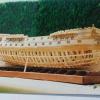-
Posts
2,848 -
Joined
-
Last visited
Reputation Activity
-
 kurtvd19 got a reaction from Ryland Craze in the chopper ii problem
kurtvd19 got a reaction from Ryland Craze in the chopper ii problem
We used the original Chopper in a production setting 8 hours a day - the groove can be filled with epoxy to level the surface. We would spread the glue at the end of the day and it was good to go in the AM - usually for a week or two. The secret to good square cuts is a sharp blade and use it for think strips - nothing over 1/8" thick. Use a miter box for the thicker stuff. Also, it will not work well with real hard wood like boxwood unless it's real thin. It's a RR modelers tool and they use basswood 99% of the time.
Kurt
-
 kurtvd19 got a reaction from WackoWolf in the chopper ii problem
kurtvd19 got a reaction from WackoWolf in the chopper ii problem
We used the original Chopper in a production setting 8 hours a day - the groove can be filled with epoxy to level the surface. We would spread the glue at the end of the day and it was good to go in the AM - usually for a week or two. The secret to good square cuts is a sharp blade and use it for think strips - nothing over 1/8" thick. Use a miter box for the thicker stuff. Also, it will not work well with real hard wood like boxwood unless it's real thin. It's a RR modelers tool and they use basswood 99% of the time.
Kurt
-
 kurtvd19 got a reaction from GuntherMT in the chopper ii problem
kurtvd19 got a reaction from GuntherMT in the chopper ii problem
We used the original Chopper in a production setting 8 hours a day - the groove can be filled with epoxy to level the surface. We would spread the glue at the end of the day and it was good to go in the AM - usually for a week or two. The secret to good square cuts is a sharp blade and use it for think strips - nothing over 1/8" thick. Use a miter box for the thicker stuff. Also, it will not work well with real hard wood like boxwood unless it's real thin. It's a RR modelers tool and they use basswood 99% of the time.
Kurt
-
 kurtvd19 got a reaction from riverboat in Table Saw Hand Safety
kurtvd19 got a reaction from riverboat in Table Saw Hand Safety
I use a shop made jig/fixture to cut repeated widths of thin stock. The clamp is an old Xacto clamp that has been narrowed to fit into the slot of the Byrnes saw. A mill is not needed - I used the carbide blade on the Byrnes saw to make the rabbet a close fit to the saw's miter groove. The wooden jig piece needs to have the ends thicker then the center area to fit to the clamp. I will be remaking the wooden piece from Plexiglas as this was just a test jig to get a job done. Now that I know it works for me the upgrade to Plexiglas will follow. The fixture is moved back, closer to the operator, when making cuts.
Kurt
-
 kurtvd19 got a reaction from hornet in Storing Wipe-on-Poly
kurtvd19 got a reaction from hornet in Storing Wipe-on-Poly
MARBLES. Use cheap easily obtained marbles to keep air out of the can. As the liquid is used up drop marbles into the can to keep the fluid right up to the top of the can. As to ease of use I would suggest a smaller container like the plastic or glass jars sold for airbrush use - they come with caps. Dispense a small amount into the small jar and add marbles to the big can. I use a cheap soft plastic pipette to transfer liquids out of bigger containers into smaller containers - no need to worry about the marbles pouring out.
Kurt
-
 kurtvd19 got a reaction from jwcola in Storing Wipe-on-Poly
kurtvd19 got a reaction from jwcola in Storing Wipe-on-Poly
MARBLES. Use cheap easily obtained marbles to keep air out of the can. As the liquid is used up drop marbles into the can to keep the fluid right up to the top of the can. As to ease of use I would suggest a smaller container like the plastic or glass jars sold for airbrush use - they come with caps. Dispense a small amount into the small jar and add marbles to the big can. I use a cheap soft plastic pipette to transfer liquids out of bigger containers into smaller containers - no need to worry about the marbles pouring out.
Kurt
-
 kurtvd19 got a reaction from shihawk in Storing Wipe-on-Poly
kurtvd19 got a reaction from shihawk in Storing Wipe-on-Poly
MARBLES. Use cheap easily obtained marbles to keep air out of the can. As the liquid is used up drop marbles into the can to keep the fluid right up to the top of the can. As to ease of use I would suggest a smaller container like the plastic or glass jars sold for airbrush use - they come with caps. Dispense a small amount into the small jar and add marbles to the big can. I use a cheap soft plastic pipette to transfer liquids out of bigger containers into smaller containers - no need to worry about the marbles pouring out.
Kurt
-
 kurtvd19 got a reaction from jwvolz in Storing Wipe-on-Poly
kurtvd19 got a reaction from jwvolz in Storing Wipe-on-Poly
MARBLES. Use cheap easily obtained marbles to keep air out of the can. As the liquid is used up drop marbles into the can to keep the fluid right up to the top of the can. As to ease of use I would suggest a smaller container like the plastic or glass jars sold for airbrush use - they come with caps. Dispense a small amount into the small jar and add marbles to the big can. I use a cheap soft plastic pipette to transfer liquids out of bigger containers into smaller containers - no need to worry about the marbles pouring out.
Kurt
-
 kurtvd19 got a reaction from janos in Storing Wipe-on-Poly
kurtvd19 got a reaction from janos in Storing Wipe-on-Poly
MARBLES. Use cheap easily obtained marbles to keep air out of the can. As the liquid is used up drop marbles into the can to keep the fluid right up to the top of the can. As to ease of use I would suggest a smaller container like the plastic or glass jars sold for airbrush use - they come with caps. Dispense a small amount into the small jar and add marbles to the big can. I use a cheap soft plastic pipette to transfer liquids out of bigger containers into smaller containers - no need to worry about the marbles pouring out.
Kurt
-
 kurtvd19 got a reaction from Ryland Craze in Storing Wipe-on-Poly
kurtvd19 got a reaction from Ryland Craze in Storing Wipe-on-Poly
MARBLES. Use cheap easily obtained marbles to keep air out of the can. As the liquid is used up drop marbles into the can to keep the fluid right up to the top of the can. As to ease of use I would suggest a smaller container like the plastic or glass jars sold for airbrush use - they come with caps. Dispense a small amount into the small jar and add marbles to the big can. I use a cheap soft plastic pipette to transfer liquids out of bigger containers into smaller containers - no need to worry about the marbles pouring out.
Kurt
-
 kurtvd19 got a reaction from ortho85 in Storing Wipe-on-Poly
kurtvd19 got a reaction from ortho85 in Storing Wipe-on-Poly
MARBLES. Use cheap easily obtained marbles to keep air out of the can. As the liquid is used up drop marbles into the can to keep the fluid right up to the top of the can. As to ease of use I would suggest a smaller container like the plastic or glass jars sold for airbrush use - they come with caps. Dispense a small amount into the small jar and add marbles to the big can. I use a cheap soft plastic pipette to transfer liquids out of bigger containers into smaller containers - no need to worry about the marbles pouring out.
Kurt
-
 kurtvd19 got a reaction from mtaylor in Storing Wipe-on-Poly
kurtvd19 got a reaction from mtaylor in Storing Wipe-on-Poly
MARBLES. Use cheap easily obtained marbles to keep air out of the can. As the liquid is used up drop marbles into the can to keep the fluid right up to the top of the can. As to ease of use I would suggest a smaller container like the plastic or glass jars sold for airbrush use - they come with caps. Dispense a small amount into the small jar and add marbles to the big can. I use a cheap soft plastic pipette to transfer liquids out of bigger containers into smaller containers - no need to worry about the marbles pouring out.
Kurt
-
 kurtvd19 got a reaction from bebopsteve in Continental Gunboat PHILADELPHIA by Chuck Seiler - Model Shipways - 1:24 Scale - Enhanced
kurtvd19 got a reaction from bebopsteve in Continental Gunboat PHILADELPHIA by Chuck Seiler - Model Shipways - 1:24 Scale - Enhanced
Chuck:
I think it will work better if you follow the planking diagram and do not use planks the full length of the boat - or close to the full length as it appears you are doing by mentioning that the fold of the file folder is a problem. The problem you are having with the spiled plank running off the width of the plank can be eliminated by using planks the length as shown on the planking diagram and cocking the plank of the strip as you thought. Of course, you need to make the rough plank a bit longer than the final plank just to allow a bit of trimming at either or both ends as you do the final fitting.
Also, get a good fit to the bottom of the plank above w/o tearing your hair out, trim the bottom of the plank to a rough width using the marks on the frames for the proper width and then wet the plank, clamp it in place, making as good a fit to the underside of the plank above and when dry do final fitting of the top edge to the plank above. Then,, do the final trimming of the lower edge of the plank to the marks from the frames, fair the edge and it should be a perfect fit.
With the top edge a close fit and then soaking the plank, a bit of edge bending to make a real tight fit can be done w/o a problem.
Take care,
Kurt
-
 kurtvd19 got a reaction from src in Table Saw Hand Safety
kurtvd19 got a reaction from src in Table Saw Hand Safety
I use a shop made jig/fixture to cut repeated widths of thin stock. The clamp is an old Xacto clamp that has been narrowed to fit into the slot of the Byrnes saw. A mill is not needed - I used the carbide blade on the Byrnes saw to make the rabbet a close fit to the saw's miter groove. The wooden jig piece needs to have the ends thicker then the center area to fit to the clamp. I will be remaking the wooden piece from Plexiglas as this was just a test jig to get a job done. Now that I know it works for me the upgrade to Plexiglas will follow. The fixture is moved back, closer to the operator, when making cuts.
Kurt
-
 kurtvd19 got a reaction from CaptainSteve in Continental Gunboat PHILADELPHIA by Chuck Seiler - Model Shipways - 1:24 Scale - Enhanced
kurtvd19 got a reaction from CaptainSteve in Continental Gunboat PHILADELPHIA by Chuck Seiler - Model Shipways - 1:24 Scale - Enhanced
Chuck:
I think it will work better if you follow the planking diagram and do not use planks the full length of the boat - or close to the full length as it appears you are doing by mentioning that the fold of the file folder is a problem. The problem you are having with the spiled plank running off the width of the plank can be eliminated by using planks the length as shown on the planking diagram and cocking the plank of the strip as you thought. Of course, you need to make the rough plank a bit longer than the final plank just to allow a bit of trimming at either or both ends as you do the final fitting.
Also, get a good fit to the bottom of the plank above w/o tearing your hair out, trim the bottom of the plank to a rough width using the marks on the frames for the proper width and then wet the plank, clamp it in place, making as good a fit to the underside of the plank above and when dry do final fitting of the top edge to the plank above. Then,, do the final trimming of the lower edge of the plank to the marks from the frames, fair the edge and it should be a perfect fit.
With the top edge a close fit and then soaking the plank, a bit of edge bending to make a real tight fit can be done w/o a problem.
Take care,
Kurt
-
 kurtvd19 got a reaction from cristikc in Table Saw Hand Safety
kurtvd19 got a reaction from cristikc in Table Saw Hand Safety
I use a shop made jig/fixture to cut repeated widths of thin stock. The clamp is an old Xacto clamp that has been narrowed to fit into the slot of the Byrnes saw. A mill is not needed - I used the carbide blade on the Byrnes saw to make the rabbet a close fit to the saw's miter groove. The wooden jig piece needs to have the ends thicker then the center area to fit to the clamp. I will be remaking the wooden piece from Plexiglas as this was just a test jig to get a job done. Now that I know it works for me the upgrade to Plexiglas will follow. The fixture is moved back, closer to the operator, when making cuts.
Kurt
-
 kurtvd19 got a reaction from mij in Table Saw Hand Safety
kurtvd19 got a reaction from mij in Table Saw Hand Safety
I use a shop made jig/fixture to cut repeated widths of thin stock. The clamp is an old Xacto clamp that has been narrowed to fit into the slot of the Byrnes saw. A mill is not needed - I used the carbide blade on the Byrnes saw to make the rabbet a close fit to the saw's miter groove. The wooden jig piece needs to have the ends thicker then the center area to fit to the clamp. I will be remaking the wooden piece from Plexiglas as this was just a test jig to get a job done. Now that I know it works for me the upgrade to Plexiglas will follow. The fixture is moved back, closer to the operator, when making cuts.
Kurt
-
 kurtvd19 got a reaction from rtropp in Table Saw Hand Safety
kurtvd19 got a reaction from rtropp in Table Saw Hand Safety
I use a shop made jig/fixture to cut repeated widths of thin stock. The clamp is an old Xacto clamp that has been narrowed to fit into the slot of the Byrnes saw. A mill is not needed - I used the carbide blade on the Byrnes saw to make the rabbet a close fit to the saw's miter groove. The wooden jig piece needs to have the ends thicker then the center area to fit to the clamp. I will be remaking the wooden piece from Plexiglas as this was just a test jig to get a job done. Now that I know it works for me the upgrade to Plexiglas will follow. The fixture is moved back, closer to the operator, when making cuts.
Kurt
-
 kurtvd19 got a reaction from WackoWolf in Table Saw Hand Safety
kurtvd19 got a reaction from WackoWolf in Table Saw Hand Safety
I use a shop made jig/fixture to cut repeated widths of thin stock. The clamp is an old Xacto clamp that has been narrowed to fit into the slot of the Byrnes saw. A mill is not needed - I used the carbide blade on the Byrnes saw to make the rabbet a close fit to the saw's miter groove. The wooden jig piece needs to have the ends thicker then the center area to fit to the clamp. I will be remaking the wooden piece from Plexiglas as this was just a test jig to get a job done. Now that I know it works for me the upgrade to Plexiglas will follow. The fixture is moved back, closer to the operator, when making cuts.
Kurt
-
 kurtvd19 got a reaction from Mark P in Water vs. Ammonia? - moved by moderator
kurtvd19 got a reaction from Mark P in Water vs. Ammonia? - moved by moderator
I have never used ammonia to bend wood - it just isn't needed. The bit below is a reprint of part of my article on building the Gunboat Philadelphia kit in Ships in Scale. I doubt anybody who attended the NRG Conference I reference has ever used ammonia since hearing it.
Kurt
AVOID AMMONIA SOAKING
At the 2007 Nautical Research Guild Conference in Manitowoc, Wisconsin Alex C. Wiendenhoeft of the U S Department of Agriculture Forest Services Center for Wood Anatomy Research at the Forest Products Laboratory in Madison, Wisconsin explained how and why this damages the wood. After this length of time I do not remember all of the details of his talk, but the point was well made and I don’t think that any of the modelers who listened to his talk that day has ever used Ammonia again. The very non-scientific points I remember is that soaking in Ammonia breaks down and liquefies the Lignin in the cells making the wood more bendable. When the Ammonia evaporates while the wood is clamped in place to the desired bend, the Lignin solidifies in a somewhat degrade state weakening the wood.
Ammonia also causes some woods to discolor when they dry out. This might not be critical when the wood is to be painted but if it is being stained or clear finished the discoloration would not be acceptable. Concentrated Ammonia fumes are used commercially to darken some woods with oak being very susceptible to this process.
Mr. Wiendenhoeft explained how and why soaking in water or steaming wood made it bendable while not damaging the cellular structure of the wood. Again, a non-scientific explanation is that there is a chemical bond with water in the cellular structure of wood that varies between 0% and 30%. Soaking or steaming wood with water raises the percentage of water within the wood, called “free water”, above the amount bonded within the cells temporarily. This makes the wood swell and more easily bent. When the wood dries out and the bonded water stabilizes back to 30% or less, the wood retains the shape it was formed to by the clamping while it dried while retaining its strength.
I have only mentioned drying the wood while clamped in place but the application of heat using some sort of plank bending tool or other heat source works the same way as clamping just at an accelerated rate.
-
 kurtvd19 got a reaction from bebopsteve in Continental Gunboat PHILADELPHIA by Chuck Seiler - Model Shipways - 1:24 Scale - Enhanced
kurtvd19 got a reaction from bebopsteve in Continental Gunboat PHILADELPHIA by Chuck Seiler - Model Shipways - 1:24 Scale - Enhanced
Looking good Chuck.
Off to the NRG Conference this AM - preliminary stuff to do for the registration when the crowd starts to arrive tomorrow. Will catch up on your build next week.
Take care,
Kurt
-
 kurtvd19 got a reaction from mtaylor in Water vs. Ammonia? - moved by moderator
kurtvd19 got a reaction from mtaylor in Water vs. Ammonia? - moved by moderator
I too am just speculating on the effects of alcohol on wood, but there is no need to use it for bending as water or water plus heat is all that is needed to bend wood and the wood returns to equilibrium leaving the original structure and strength. If Marc wades in on the effects I will be all ears, but in my opinion, it's probably doing something to the wood that isn't going to make things better than before it was used.
I do use regular Isopropyl Alcohol to soften yellow carpenters glue (Elmers & Titebond)glue to undo joints. Some say that the 90% stuff that needs to be obtained by special order is needed but I have never needed anything more than common and cheap Isopropyl. I have never had the occasion to soak a glued piece of wood. I apply the alcohol to the joint with a "Q" Tip or a syringe depending on how large the joint is - the more glue that was used the more alcohol that will be needed. I saturate the area of the glue joint and wait a bit but I keep an eye on it so the alcohol doesn't dry our before I apply more. I test the joint and as soon as it wiggles loose I remove the piece and I try to scrape any of the softened glue off the pieces. I let them dry before re-gluing the joint.
Kurt
-
 kurtvd19 got a reaction from cdogg in Water vs. Ammonia? - moved by moderator
kurtvd19 got a reaction from cdogg in Water vs. Ammonia? - moved by moderator
I have never used ammonia to bend wood - it just isn't needed. The bit below is a reprint of part of my article on building the Gunboat Philadelphia kit in Ships in Scale. I doubt anybody who attended the NRG Conference I reference has ever used ammonia since hearing it.
Kurt
AVOID AMMONIA SOAKING
At the 2007 Nautical Research Guild Conference in Manitowoc, Wisconsin Alex C. Wiendenhoeft of the U S Department of Agriculture Forest Services Center for Wood Anatomy Research at the Forest Products Laboratory in Madison, Wisconsin explained how and why this damages the wood. After this length of time I do not remember all of the details of his talk, but the point was well made and I don’t think that any of the modelers who listened to his talk that day has ever used Ammonia again. The very non-scientific points I remember is that soaking in Ammonia breaks down and liquefies the Lignin in the cells making the wood more bendable. When the Ammonia evaporates while the wood is clamped in place to the desired bend, the Lignin solidifies in a somewhat degrade state weakening the wood.
Ammonia also causes some woods to discolor when they dry out. This might not be critical when the wood is to be painted but if it is being stained or clear finished the discoloration would not be acceptable. Concentrated Ammonia fumes are used commercially to darken some woods with oak being very susceptible to this process.
Mr. Wiendenhoeft explained how and why soaking in water or steaming wood made it bendable while not damaging the cellular structure of the wood. Again, a non-scientific explanation is that there is a chemical bond with water in the cellular structure of wood that varies between 0% and 30%. Soaking or steaming wood with water raises the percentage of water within the wood, called “free water”, above the amount bonded within the cells temporarily. This makes the wood swell and more easily bent. When the wood dries out and the bonded water stabilizes back to 30% or less, the wood retains the shape it was formed to by the clamping while it dried while retaining its strength.
I have only mentioned drying the wood while clamped in place but the application of heat using some sort of plank bending tool or other heat source works the same way as clamping just at an accelerated rate.
-
 kurtvd19 got a reaction from jwvolz in Water vs. Ammonia? - moved by moderator
kurtvd19 got a reaction from jwvolz in Water vs. Ammonia? - moved by moderator
I have never used ammonia to bend wood - it just isn't needed. The bit below is a reprint of part of my article on building the Gunboat Philadelphia kit in Ships in Scale. I doubt anybody who attended the NRG Conference I reference has ever used ammonia since hearing it.
Kurt
AVOID AMMONIA SOAKING
At the 2007 Nautical Research Guild Conference in Manitowoc, Wisconsin Alex C. Wiendenhoeft of the U S Department of Agriculture Forest Services Center for Wood Anatomy Research at the Forest Products Laboratory in Madison, Wisconsin explained how and why this damages the wood. After this length of time I do not remember all of the details of his talk, but the point was well made and I don’t think that any of the modelers who listened to his talk that day has ever used Ammonia again. The very non-scientific points I remember is that soaking in Ammonia breaks down and liquefies the Lignin in the cells making the wood more bendable. When the Ammonia evaporates while the wood is clamped in place to the desired bend, the Lignin solidifies in a somewhat degrade state weakening the wood.
Ammonia also causes some woods to discolor when they dry out. This might not be critical when the wood is to be painted but if it is being stained or clear finished the discoloration would not be acceptable. Concentrated Ammonia fumes are used commercially to darken some woods with oak being very susceptible to this process.
Mr. Wiendenhoeft explained how and why soaking in water or steaming wood made it bendable while not damaging the cellular structure of the wood. Again, a non-scientific explanation is that there is a chemical bond with water in the cellular structure of wood that varies between 0% and 30%. Soaking or steaming wood with water raises the percentage of water within the wood, called “free water”, above the amount bonded within the cells temporarily. This makes the wood swell and more easily bent. When the wood dries out and the bonded water stabilizes back to 30% or less, the wood retains the shape it was formed to by the clamping while it dried while retaining its strength.
I have only mentioned drying the wood while clamped in place but the application of heat using some sort of plank bending tool or other heat source works the same way as clamping just at an accelerated rate.
-
 kurtvd19 got a reaction from Perls in Water vs. Ammonia? - moved by moderator
kurtvd19 got a reaction from Perls in Water vs. Ammonia? - moved by moderator
I have never used ammonia to bend wood - it just isn't needed. The bit below is a reprint of part of my article on building the Gunboat Philadelphia kit in Ships in Scale. I doubt anybody who attended the NRG Conference I reference has ever used ammonia since hearing it.
Kurt
AVOID AMMONIA SOAKING
At the 2007 Nautical Research Guild Conference in Manitowoc, Wisconsin Alex C. Wiendenhoeft of the U S Department of Agriculture Forest Services Center for Wood Anatomy Research at the Forest Products Laboratory in Madison, Wisconsin explained how and why this damages the wood. After this length of time I do not remember all of the details of his talk, but the point was well made and I don’t think that any of the modelers who listened to his talk that day has ever used Ammonia again. The very non-scientific points I remember is that soaking in Ammonia breaks down and liquefies the Lignin in the cells making the wood more bendable. When the Ammonia evaporates while the wood is clamped in place to the desired bend, the Lignin solidifies in a somewhat degrade state weakening the wood.
Ammonia also causes some woods to discolor when they dry out. This might not be critical when the wood is to be painted but if it is being stained or clear finished the discoloration would not be acceptable. Concentrated Ammonia fumes are used commercially to darken some woods with oak being very susceptible to this process.
Mr. Wiendenhoeft explained how and why soaking in water or steaming wood made it bendable while not damaging the cellular structure of the wood. Again, a non-scientific explanation is that there is a chemical bond with water in the cellular structure of wood that varies between 0% and 30%. Soaking or steaming wood with water raises the percentage of water within the wood, called “free water”, above the amount bonded within the cells temporarily. This makes the wood swell and more easily bent. When the wood dries out and the bonded water stabilizes back to 30% or less, the wood retains the shape it was formed to by the clamping while it dried while retaining its strength.
I have only mentioned drying the wood while clamped in place but the application of heat using some sort of plank bending tool or other heat source works the same way as clamping just at an accelerated rate.


















